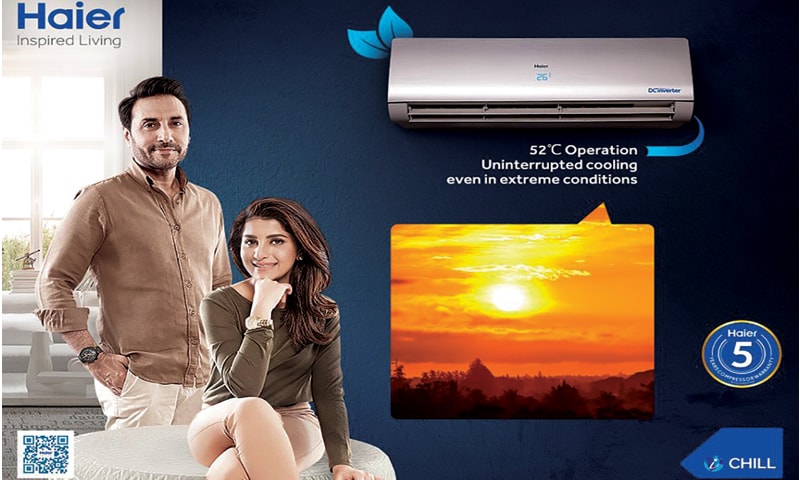How China is keeping Pakistanis cool
Published in Jan-Feb 2017
Pakistan’s air-conditioner (AC) industry has witnessed interesting developments. With penetration standing at a meagre 10% (source: The Pakistan Credit Rating Agency, 2016), significantly lower than the 90% mark of developed countries, combined with an expanding middle class with larger disposable incomes, the demand has been on the rise. This has prompted several Chinese manufacturers to enter the market in the last three years, bringing with them innovative technologies and extensive marketing campaigns.
The production volume of the market in Pakistan is estimated at 600,000-650,000 units per annum. In terms of share, Chinese brands Haier (at 23%) and Gree (at 22%) enjoy the lion’s share, with local manufacturers such as Orient (at 16%), PEL (at 6%) and Dawlance (at 4%) struggling to keep up.
As Gallup Pakistan statistics indicate, the industry scenario was very different before China’s entry. Window ACs dominated the market and PEL controlled 75% of the market (along with GE), mainly because it was one of the first local brands to launch window ACs and therefore enjoyed the first-mover advantage. Split ACs were almost non-existent due to the lack of trained technicians to service them, the non-availability of replacement parts and the considerably higher price tags (approximately 80% higher, according to the Federal Bureau of Statistics, 2012). However, things began to change when more affordable split AC brands (local and international) began to enter the market and slowly encroached on PEL’s substantial customer base.
Up to this point, because of exorbitantly high power tariffs and electricity guzzling outdated technology, ACs were considered luxury appliances. With increasing imports from China of affordable split ACs, consumers suddenly had plenty of cost-effective brand choices. Retailers in Sindh and Punjab (the two provinces that constitute more than 85% of the market) attribute PEL’s decline to higher prices and delays in bringing energy-efficient technologies to market.
However, according to Muhammad Shahid, Category Manager, PEL, “our focus has always been on providing quality products that are durable, and we believe that jumping on to the latest technologies without proper R&D is irresponsible and unsustainable as a business strategy.” Shahid believes that in the end, brands offering quality rather than cost-effectiveness will survive.
Within the last three years, Chinese brands have flooded the market, and according to retail sales estimates, account for almost 80-90% of the total annual sales.
Zeeshan Ali Khan, Media Manager, Orient has a contrasting viewpoint. In his opinion, the negative perceptions about Chinese products have changed over the years and “the average buyer is looking to save electricity and the brand that delivers this benefit will be the quickest to disappear off the shelf.”
This observation was validated by an informal audit of the electronics market in Lahore.
Within the last three years, Chinese brands have flooded the market, and according to retail sales estimates, account for almost 80 to 90% of the total annual sales. According to Iqbal Riaz, owner of an electronic appliance outlet in Gulberg (Lahore), “the two most frequently asked questions are how quickly it cools and by how much will the electricity bill increase.”
This suggests that the value-added features, such as air filtering, cellular or Bluetooth connectivity and smart compressors, are secondary variables. In Riaz’s opinion, the reason why Chinese brands have gained such a strong foothold is because they introduced ACs that functioned on inverters, thereby promising energy savings of up to 60%.
Chinese brands that have created the most buzz on media, and subsequently in the market, have primarily been Gree and Haier.

Shoaib Younus, Senior Marketing Services Manager, Gree, attributes the brand’s success to superior technology, but more importantly, to the extensive advertising campaigns executed throughout the year. A review of Gree’s campaigns thus far reveals that the brand opted for functional advertising to increase awareness of how inverter ACs are different and what benefits can they deliver.
With taglines ranging from ‘Khoob chalain, khoob bachain’,‘Khoob thanda karey’ and ‘Aaj, kal parson, chaley barson’, the brand has focussed on conveying the fact that not only do Gree ACs cool a room quickly (and are therefore cost-effective in the long-run), they are also very durable.
Humayoun Bashir, Marketing Manager, Haier, concurs with Younus’ assessment. “We invested heavily in advertising to make the market aware about inverter technology. Initially people were apprehensive, and it took a while to gain their trust that this was not a marketing gimmick.”
Muhammad Kashif Amin, Executive Director, Blitz Advertising (Haier’s creative agency), said that glossy campaigns would not have helped. “Instead our focus was explaining the specifications of our inverter ACs through our TVCs and print ads.” This is evident from the visuals of Adnan Siddiqui (their brand ambassador) operating different controls and explaining the utility of each in the TVC; added to this were the print campaigns which highlighted the cost savings Haier offer. ‘Chill out and look ahead to 100% saving’ and ‘Kill Bill offer’ are some of the taglines Haier has used this year.
Local players PEL and Dawlance have also launched their inverter ACs and most of their advertising has been reactive. PEL came up with ‘Saving waala AC’ campaign and Dawlance came with ‘It’s almost free’. Judging from the sales trends reported by retailers, these campaigns failed to leave their mark on consumers.
Only time will tell if the local brands will be able to improve their technology, as well as their marketing campaigns, to compete with the Chinese brands. The road ahead is not going to get any smoother because with CPEC in full flow, even more Chinese brands are expected to enter the market, creating more competition, which in all likelihood will drive prices further down, and force brands to keep innovating.



Comments (19) Closed